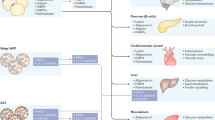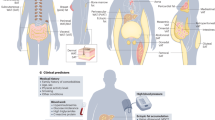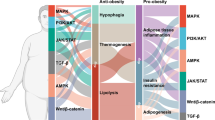Abstract
Adiponectin and adiponectin receptors (AdipoRs) have been found to play significant roles in the etiology of obesity-related chronic disease. Their discovery has been a long and complicated path, with many challenges. Developing methods to unravel the molecular secrets has been an informative process in itself. However, with both functional and genetic studies confirming adiponectin as a therapeutic target adipokine, many roles and interactions with certain other biomolecules have been clearly defined. We have found that decreased high molecular weight (HMW) adiponectin plays a crucial and causal role in obesity-linked insulin resistance and metabolic syndrome; that AdipoR1 and AdipoR2 serve as the major AdipoRs in vivo; and that AdipoR1 activates the AMP kinase (AMPK) pathway and AdipoR2, the peroxisome proliferator-activated receptor alpha (PPARα) pathway in the liver, to increase insulin sensitivity and decrease inflammation. Further conclusions are that decreased adiponectin action and increased monocyte chemoattractant protein-1 (MCP-1) form a vicious adipokine network causing obesity-linked insulin resistance and metabolic syndrome; PPARγ upregulates HMW adiponectin and PPARα upregulates AdipoRs; that dietary osmotin can serve as a naturally occurring adiponectin receptor agonist; and finally, that under starvation conditions, MMW adiponectin activates AMPK in hypothalamus, and promotes food intake, and at the same time HMW adiponectin activates AMPK in peripheral tissues, such as skeletal muscle, and stimulates fatty-acids combustion. Importantly, under pathophysiological conditions, such as obesity and diabetes, only HMW adiponectin was decreased; therefore, strategies to increase only HMW adiponectin may be a logical approach to provide a novel treatment modality for obesity-linked diseases, such as insulin resistance and type 2 diabetes. It is hoped that these data will be helpful in developing treatments to counteract the destructive, expensive and painful effects of obesity.
This is a preview of subscription content, access via your institution
Access options
Subscribe to this journal
Receive 12 print issues and online access
$259.00 per year
only $21.58 per issue
Buy this article
- Purchase on Springer Link
- Instant access to full article PDF
Prices may be subject to local taxes which are calculated during checkout






Similar content being viewed by others
References
Scherer PE, Williams S, Fogliano M, Baldini G, Lodish HF . A novel serum protein similar to C1q, produced exclusively in adipocytes. J Biol Chem 1995; 270: 26746–26749.
Maeda K, Okubo K, Shimomura I, Funahashi T, Matsuzawa Y, Matsubara K . cDNA cloning and expression of a novel adipose specific collagen-like factor, apM1 (AdiPose Most abundant Gene transcript 1). Biochem Biophys Res Commun 1996; 221: 286–296.
Hu E, Liang P, Spiegelman BM . AdipoQ is a novel adipose-specific gene dysregulated in obesity. J Biol Chem 1996; 271: 10697–10703.
Nakano Y, Tobe T, Choi-Miura NH, Mazda T, Tomita M . Isolation and characterization of GBP28, a novel gelatin-binding protein purified from human plasma. J Biochem (Tokyo) 1996; 120: 802–812.
Fruebis J, Tsao TS, Javorschi S, Ebbets-Reed D, Erickson MR, Yen FT et al. Proteolytic cleavage product of 30-kDa adipocyte complement-related protein increases fatty acid oxidation in muscle and causes weight loss in mice. Proc Natl Acad Sci USA 2001; 98: 2005–2010.
Yamauchi T, Kamon J, Waki H, Terauchi Y, Kubota N, Hara K et al. The fat-derived hormone adiponectin reverses insulin resistance associated with both lipoatrophy and obesity. Nat Med 2001; 7: 941–946.
Berg AH, Combs TP, Du X, Brownlee M, Scherer PE . The adipocyte-secreted protein Acrp30 enhances hepatic insulin action. Nat Med 2001; 7: 947–953.
Hug C, Lodish HF . The role of the adipocyte hormone adiponectin in cardiovascular disease. Cur Opin Pharmacol 2005; 5: 129–134.
Scherer PE . Adipose tissue: from lipid storage compartment to endocrine organ. Diabetes 2006; 55: 1537–1545.
Matsuzawa Y . The metabolic syndrome and adipocytokines. FEBS Lett 2006; 580: 2917–2921.
Kadowaki T, Yamauchi T, Kubota N, Hara K, Ueki K, Tobe K . Adiponectin and adiponectin receptors in insulin resistance, diabetes, and the metabolic syndrome. J Clin Invest 2006; 116: 1784–1792.
Yamauchi T, Kamon J, Minokoshi Y, Ito Y, Waki H, Uchida S et al. Adiponectin stimulates glucose utilization and fatty-acid oxidation by activating AMP-activated protein kinase. Nat Med 2002; 8: 1288–1295.
Tomas E, Tsao TS, Saha AK, Murrey HE, Zhang Cc C, Itani SI et al. Enhanced muscle fat oxidation and glucose transport by ACRP30 globular domain: acetyl-CoA carboxylase inhibition and AMP-activated protein kinase activation. Proc Natl Acad Sci USA 2002; 99: 16309–16313.
Yamauchi T, Kamon J, Waki H, Imai Y, Shimozawa N, Hioki K et al. Globular adiponectin protected ob/ob mice from diabetes and apoE deficient mice from atherosclerosis. J Biol Chem 2003; 278: 2461–2468.
Yamauchi T, Kamon J, Ito Y, Tsuchida A, Yokomizo T, Kita S et al. Cloning of adiponectin receptors that mediate antidiabetic metabolic effects. Nature 2003; 423: 762–769.
Yamauchi T, Nio Y, Maki T, Kobayashi M, Takazawa T, Iwabu M et al. Targeted disruption of AdipoR1 and AdipoR2 causes abrogation of adiponectin binding and metabolic actions. Nat Med 2007; 13: 332–339.
Wellen KE, Hotamisligil GS . Obesity-induced inflammatory changes in adipose tissue. J Clin Invest 2003; 112: 1785–1788.
Kamei N, Tobe K, Suzuki R, Ohsugi M, Watanabe T, Kubota N et al. Overexpression of MCP-1 in adipose tissues causes macrophage recruitment and insulin resistance. J Biol Chem 2006; 281: 26602–26614.
Kanda H, Tateya S, Tamori Y, Kotani K, Hiasa K, Kitazawa R et al. MCP-1 contributes to macrophage infiltration into adipose tissue, insulin resistance, and hepatic steatosis in obesity. J Clin Invest 2006; 116: 1494–1505.
Waki H, Yamauchi T, Kamon J, Ito Y, Uchida S, Kita S et al. Impaired multimerization of human adiponectin mutants associated with diabetes: molecular structure and multimer formation of adiponectin. J Biol Chem 2003; 278: 40352–40363.
Hada Y, Yamauchi T, Waki H, Tsuchida A, Hara K, Yago H et al. Selective purification and characterization of adiponectin multimer species from human plasma. Biochem Biophys Res Commun 2007; 356: 487–493.
Tsuchida A, Yamauchi T, Takekawa S, Hada Y, Ito Y, Maki T et al. Peroxisome proliferator-activated receptor (PPAR)alpha activation increases adiponectin receptors and reduces obesity-related inflammation in adipose tissue: comparison of activation of PPARalpha, PPARgamma, and their combination. Diabetes 2005; 54: 3358–3370.
Ebinuma H, Miyazaki O, Yago H, Hara K, Yamauchi T, Kadowaki T . A novel ELISA system for selective measurement of human adiponectin multimers by using proteases. Clin Chim Acta 2006; 372: 47–53.
Hara K, Horikoshi M, Yamauchi T, Yago H, Miyazaki O, Ebinuma H et al. Measurement of the high-molecular weight form of adiponectin in plasma is useful for the prediction of insulin resistance and metabolic syndrome. Diabetes Care 2006; 29: 1357–1362.
Kubota N, Terauchi Y, Kubota T, Kumagai H, Itoh S, Satoh H et al. Pioglitazone ameliorates insulin resistance and diabetes by both adiponectin-dependent and -independent pathways. J Biol Chem 2006; 281: 8748–8755.
Tsuchida A, Yamauchi T, Ito Y, Hada Y, Maki T, Takekawa S et al. Insulin/Foxo1 pathway regulates expression levels of adiponectin receptors and adiponectin sensitivity. J Biol Chem 2004; 279: 30817–30822.
Narasimhan LM, Coca MA, Jin J, Yamauchi T, Ito Y, Kadowaki T et al. Osmotin is a homolog of mammalian adiponectin and controls apoptosis in yeast through a homolog of mammalian adiponectin receptor. Mol Cell 2005; 17: 171–180.
Kubota N, Yano W, Kubota T, Yamauchi T, Itoh S, Kumagai H et al. Adiponectin stimulates AMP-activated protein kinase in the hypothalamus and increases food intake. Cell Metab 2007; 6: 55–68.
Acknowledgements
We thank K Ueki, K Hara, N Kubota, M Iwabu, M Iwabu-Okada, T Shimizu and R Nagai for their advice and helpful discussions. This study was supported by a grant from the Program for Promotion of Fundamental Studies in Health Sciences of the Organization for Pharmaceutical Safety and Research of Japan (to TK), a grant-in-aid for the Development of Innovative Technology from the Japanese Ministry of Education, Culture, Sports, Science and Technology (to TK) and Health Science Research Grants (Research on Human Genome and Gene Therapy) from the Japanese Ministry of Health, Labour and Welfare (to TK and TY).
Author information
Authors and Affiliations
Corresponding author
Additional information
Conflict of interest
The authors have declared no financial interests.
Rights and permissions
About this article
Cite this article
Yamauchi, T., Kadowaki, T. Physiological and pathophysiological roles of adiponectin and adiponectin receptors in the integrated regulation of metabolic and cardiovascular diseases. Int J Obes 32 (Suppl 7), S13–S18 (2008). https://doi.org/10.1038/ijo.2008.233
Published:
Issue Date:
DOI: https://doi.org/10.1038/ijo.2008.233
Keywords
This article is cited by
-
Temporal relationships between BMI and obesity-related predictors of cardiometabolic and breast cancer risk in a longitudinal cohort
Scientific Reports (2023)
-
Do patients with Prader–Willi syndrome have favorable glucose metabolism?
Orphanet Journal of Rare Diseases (2022)
-
Synthetic adiponectin-receptor agonist, AdipoRon, induces glycolytic dependence in pancreatic cancer cells
Cell Death & Disease (2022)
-
Sputum and plasma adiponectin levels in clinically stable adult cystic fibrosis patients with CFTR I1234V mutation
Translational Medicine Communications (2020)
-
Theoretical study of the adiponectin receptors: binding site characterization and molecular dynamics of possible ligands for drug design
SN Applied Sciences (2020)



